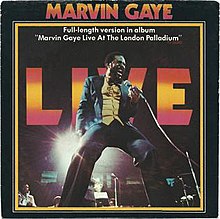Got To Give It Up
| "Got to Give It Up" | ||||
|---|---|---|---|---|

Picture sleeve for one of U.S. vinyl singles
|
||||
| Single by Marvin Gaye | ||||
| from the album Live at the London Palladium | ||||
| A-side | "Got to Give It Up" (Pt. 1) | |||
| B-side | "Got to Give It Up" (Pt. 2) | |||
| Released | March 15, 1977 | |||
| Format | 7" single, 12" single | |||
| Recorded | December 1976 Marvin's Room, Los Angeles, California |
|||
| Genre | Disco, jazz-funk, soul, R&B | |||
| Length | 11:52 (Full-length version) 4:12 (Single version) |
|||
| Label | Tamla | |||
| Writer(s) | Marvin Gaye | |||
| Producer(s) | Art Stewart | |||
| Marvin Gaye singles chronology | ||||
|
||||
| "Got to Give It Up" | |||||||||||||
|---|---|---|---|---|---|---|---|---|---|---|---|---|---|
 |
|||||||||||||
| Single by Aaliyah featuring Slick Rick | |||||||||||||
| from the album One in a Million | |||||||||||||
| B-side | "No Days Go By" | ||||||||||||
| Released | October 8, 1996 | ||||||||||||
| Format | CD single, 12-inch single | ||||||||||||
| Recorded | October 1995 Spectrum Studios (Greensboro, NC) Larrabee Studios (Los Angeles, CA) |
||||||||||||
| Genre | R&B, funk, hip hop soul | ||||||||||||
| Length | 4:02 (radio edit) 4:41 (album version) |
||||||||||||
| Label | Blackground/Atlantic Records | ||||||||||||
| Writer(s) | Marvin Gaye, Slick Rick, Michael Jackson | ||||||||||||
| Producer(s) | Kay Gee | ||||||||||||
| Aaliyah singles chronology | |||||||||||||
|
|||||||||||||
"Got to Give It Up" is a song by American music artist Marvin Gaye. Written by the singer and produced by Art Stewart as a response to a request from Gaye's record label that he perform disco music, it was released in March of 1977.
Upon its release, it topped three different Billboard charts and also became a worldwide success. Gaye sometimes used the song to open up his live concert shows. The song has been covered by several acts.
Throughout 1976, Marvin Gaye's popularity was still at a high in America and abroad, but the singer struggled throughout the year due to pending lawsuits from former band mates. Divorce court proceedings between Gaye and first wife Anna Gordy had put a strain on him. Financial difficulties almost led to imprisonment for the singer when Gordy accused him of failing to pay child support payments for their only child, son Marvin Pentz Gaye III.
To relieve Gaye from his debt, his European concert promoter Jeffrey Kruger booked the singer on a lengthy European tour. Gaye began the tour in the United Kingdom where he had a strong fan base dating back to his early career in the 1960s, making his first stop in the country since 1964. His performances there were given rave reviews. One of the shows, filmed at London's Palladium, was recorded for a live album, later released as Live at the London Palladium, in the spring of 1977. Around the same time, Gaye's label Motown tried to get the artist to record in the current sound of the times, disco music. Gaye criticized the music, claiming it lacked substance and vowed against recording in the genre. His label mate Diana Ross had recorded her first disco song, "Love Hangover". The song's producer Hal Davis debated over giving that song to either Ross or Gaye. After working over the song, he went with Ross, and it became her fourth solo number one hit. Motown struggled to get Gaye in the studio as Gaye focused on work on an album (which would later be released as Here, My Dear, dedicated to Gaye's troubled first marriage). After months of holding off from recording anything resembling disco, the singer set upon writing a song parodying a disco setting.
...
Wikipedia
